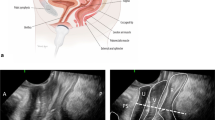Abstract
Purpose
Magnetic resonance imaging (MRI) of the pelvic floor has become a commonly requested diagnostic tool for pelvic floor assessment. We provide a practical guide for developing, growing, and troubleshooting a dedicated pelvic floor imaging service.
Methods
The authors provide an organized approach to the development of a pelvic floor MRI program based on the experience of the SAR Pelvic Floor Disease Focused Panel in academic and private practice settings. Topics addressed include creating interest, staff education, patient preparation both before and after arrival to the imaging center, image acquisition, reporting, and troubleshooting.
Results
Using the organization and approach in this guide, the challenge of growing this relatively complex imaging program can be simplified. Familiarity with best practices and established techniques used by successful programs will allow new sites to avoid early pitfalls and quickly develop a mature and autonomous workflow.
Conclusions
The development and growing of a pelvic floor MRI program presents its own set of challenges and unique workflow issues which can create anxiety in both patients and providers. We systematically present an approach to streamline the development of a successful pelvic floor MRI program.



Similar content being viewed by others
References
Colaiacomo MC, Masselli G, Polettini E, Lanciotti S, Casciani E, Bertini L, Gualdi G. (2009) Dynamic MR imaging of the pelvic floor: a pictorial review. Radiographics 29(3)
El Sayed RF, Alt CD, Maccioni F, Meissnitzer M, Masselli G, Manganaro L, Vinci V, Weishaupt D, Group EaEPFW (2017) Magnetic resonance imaging of pelvic floor dysfunction - joint recommendations of the ESUR and ESGAR Pelvic Floor Working Group. Eur Radiol 27(5):2067–2085.
Wallden L (1953) Roentgen Examination of the Deep Rectogenital Pouch. Acta Radiol 39(2): 105–116.
Mahieu P, Pringot J, Bodart P (1984) Defacography. I. Description of a new procedure and results in normal patients. Gastrointest Radiol 9: 247–251.
Harvey CJ, Halligan S, Bartram CI, Holing N, Sahdev A, Kingston K (1999) Evacuation proctography: a prospective study of diagnostic and therapeutic effects. Radiology 211: 223–237.
Dietz HP, Haylen BT, Broome J (2001) Ultrasound in the quantification of female pelvic organ prolapse. Ultrasound Obstet Gynecol 18: 511–514.
Goodrich MA, Webb MJ, King BF, Bampton AE, Campeau NG, Riederer SJ (1993) Magnetic resonance imaging of pelvic floor relaxation: dynamic analysis and evaluation of patients before and after surgical repair. Obstet Gynecol 82: 883–831.
Yang A, Mostwin JL, Rosenheim NB, Zerhouni EA (1991) Pelvic floor descent in women: dynamic evaluation with fast MR imaging and cinematic display Radiology 179: 25–33.
Hetzer FH, Andreisek G, Tsagari C, Sahrbacher U, Weishaupt D (2006) MR defecography in patients with fecal incontinence: imaging findings and their effects on surgical management. Radiology 240: 449–457.
Kagoma YK, Netz RJ, Strain A, Larson DB (2018) Improving and Maintaining Radiologic Technologist Skill Using a Medical Director Partnership and Technologist Coaching Model. AJR Am J Roentgenol. Nov;211(5):986-992.
Khatri G (2014) Magnetic resonance imaging of pelvic floor disorders. Top Magn Reson Imaging 23(4):259-273.
El Sayed FR (2013) The urogynecological side of pelvic floor MRI: the clinician’s needs and the radiologist’s role. Abdom Imaging 38(5):912–929.
Lalwani N, Moshiri M, Lee JH, Bhargava P, Dighe MK (2013) Magnetic resonance imaging of pelvic floor dysfunction. Radiol Clin North Am 51(6):1127–1139.
Al-Najar MS, Ghanem AF, AlRyalat SAS, Al-Ryalat NT, Alhajahjeh SO (2017) The usefulness of MR defecography in the evaluation of pelvic floor dysfunction: our experience using 3T MRI. Abdom Radiol. 42(9):2219–2224.
Law YM, Fielding JR (2008) MRI of pelvic floor dysfunction: review. AJR Am J Roentgenol 191(6 Suppl):S45–53.
Reginelli A, Di Grezia G, Gatta G, Iacobellis F, Rossi C, Giganti M, Coppolino F, Brunese L (2013) Role of conventional radiology and MRi defecography of pelvic floor hernias. BMC Surg, 13 Suppl 2:S53.
Acuff SN, Bradley YC, Barlow P, Osborne DR (2014) Reduction of patient anxiety in PET/CT imaging by improving communication between patient and technologist. J Nucl Med Technol. Sep42(3):211–7
Bertschinger, K.M., Hetzer, F.H., Roos, J.E. et al (2002) Dynamic MR imaging of the pelvic floor performed with patient sitting in an open-magnet unit versus with patient supine in a closed-magnet unit. Radiology, 223:501–508.
CS Reiner, D Weishaupt (2013) Dynamic pelvic floor imaging: MRI techniques and imaging parameters. Abdom Imaging 38:903–911
Flusberg M, Sahni VA, Erturk SM, Mortele KJ (2011) Dynamic MR defecography: assessment of the usefulness of the defecation phase. AJR Am J Roentgenol. Apr;196(4):394–9.
Huang T-Y, Huang I-J, Chen C-Y, et al. (2002) Are TrueFISP images T2/T1-weighted? Magn Reson Med, 48:684–688.
Scheffler K, Hennig J. (2013) Is TrueFISP a gradient-echo or a spin-echo sequence? Magn Reson Med, 49:395–7.
Arif-Tiwari H, Twiss CO, Lin FC, Funk JT, Vedantham S, Martin DR, Kalb BT (2018) Improved detection of pelvic organ prolapse: comparative utility of defecography phase sequence to nondefecography Valsalva maneuvers in dynamic pelvic floor magnetic resonance imaging. Curr Probl Diagn Radiol [Epub ahead of print].
Author information
Authors and Affiliations
Corresponding author
Additional information
Publisher's Note
Springer Nature remains neutral with regard to jurisdictional claims in published maps and institutional affiliations.
The views expressed in this presentation are those of the authors and do not necessarily reflect the official policy or position of the Department of the Navy, Department of Defense, or the United States Government.
The author(s) are military service members. This work was prepared as part of official duties. Title 17 U.S.C. 105 provides that ‘Copyright protection under this title is not available for any work of the United States Government.’
Rights and permissions
About this article
Cite this article
Steiner, A., Marks, R., Bahrami, S. et al. How to develop and sustain a successful pelvic floor MRI practice. Abdom Radiol 46, 1443–1450 (2021). https://doi.org/10.1007/s00261-019-02204-y
Published:
Issue Date:
DOI: https://doi.org/10.1007/s00261-019-02204-y




